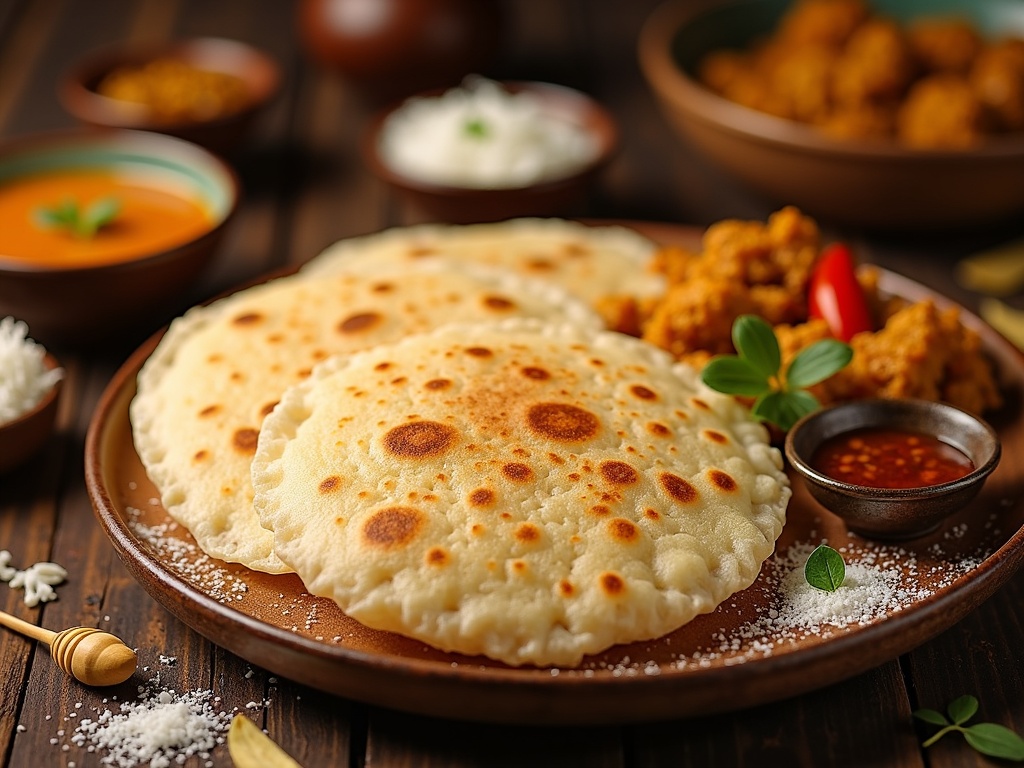Appam recipe, a South Indian and Sri Lankan delicacy, features a unique texture with a soft, fluffy center that transitions into delicate, lacy edges created from fermented rice flour and coconut milk. This traditional dish not only offers a distinctive eating experience but also provides nutritional benefits through its natural fermentation process, making it both a versatile and wholesome addition to various meal pairings.
Find In This Article
Key Takeaways
- The perfect appam requires quality ingredients including idli rice, fresh grated coconut, and proper fermentation for 8-12 hours to develop its signature texture and flavor.
- A traditional appam pan with its curved bottom is ideal for creating the characteristic thick center and crispy edges, though a covered non-stick skillet can work as an alternative.
- The batter preparation technique involving proper soaking, grinding, and fermentation is crucial for achieving the authentic texture and subtle tangy flavor.
- Appam pairs excellently with traditional accompaniments like vegetable ishtu, mutton stew, or simple coconut milk, and is best served immediately after cooking.
- This naturally gluten-free dish offers digestive benefits through its fermentation process, providing probiotics while maintaining a moderate caloric profile of 250-300 calories per serving.
What Makes Appam Special
Appam stands out as a distinctive South Indian and Sri Lankan delicacy that’s captured my heart with its unique texture and flavor profile. This traditional dish features a soft, fluffy center that gradually transitions into delicate, lacy edges—creating an eating experience that’s both satisfying and visually appealing.
A Perfect Blend of Tradition and Nutrition
The magic of appam lies in its simple yet transformative ingredients. I’ve found that the combination of fermented rice flour and coconut milk creates a batter that, when cooked, develops those characteristic textures that make appam so special. The fermentation process not only enhances the flavor but also makes appam naturally probiotic-rich, supporting gut health with every bite.
As an integral part of Kerala cuisine, appam pairs beautifully with savory dishes like vegetable sambar or flavorful chicken korma. The neutral, slightly sweet taste of appam provides the perfect canvas for bold, spicy curries to shine.
What I particularly appreciate about appam is its accessibility for those with dietary restrictions. It’s naturally gluten-free, making it an excellent alternative to wheat-based breads for those with gluten sensitivities. The fermentation process also breaks down anti-nutrients in the rice, increasing the bioavailability of nutrients.
The versatility of appam extends beyond just savory pairings. I’ve enjoyed variations where palm sugar or jaggery is added to create a sweeter version that works wonderfully with fruits or a drizzle of honey. Some regions even prepare it with a touch of spicy flavors for a unique twist.
For home cooks looking to expand their repertoire beyond staples like pulao or dal makhani, appam offers a relatively simple entry point into South Indian cuisine. While mastering the perfect lacy edges might take practice, the basic recipe is forgiving and rewards experimentation.
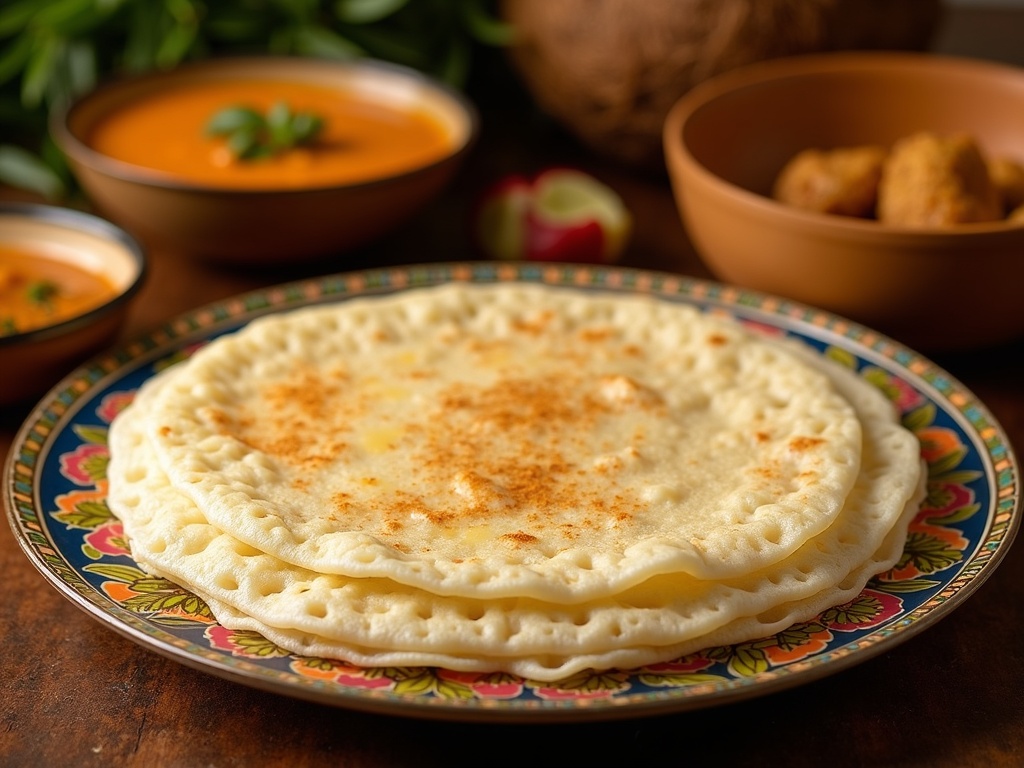
Essential Ingredients and Equipment
The perfect appam starts with gathering the right ingredients and tools. I’ve found that quality ingredients make all the difference in creating these delicate, lacy pancakes with their signature soft center.
Key Ingredients
For authentic appams, I start with 2 cups of boiled rice, though a combination of boiled and raw rice works wonderfully too. Idli rice is my preferred choice as it gives appams their distinct texture. The starch content in this rice variety helps achieve that perfect balance between crispy edges and a soft center.
Fresh grated coconut is essential – about 1 cup gives appams their subtle sweetness and distinct flavor. I always add 1 teaspoon of sugar to enhance the natural sweetness and help with fermentation. For leavening, either 1 teaspoon of active dry yeast or 1/4 teaspoon of baking soda works, though yeast gives a better flavor depth similar to what you might find in a fluffy dhokla. Don’t forget salt to taste – it balances the sweetness perfectly.
Necessary Equipment
The traditional appam pan is irreplaceable for authentic results. These specialized pans have a curved bottom that creates the signature thick, soft center while allowing the batter to spread thin at the edges for crispy perfection. If you’re also a fan of other Indian classics like homemade sambar, you’ll appreciate how proper equipment elevates simple dishes.
If you don’t have an appam pan, a non-stick skillet can work in a pinch, though you won’t get the same dome shape. The key difference is that traditional appam pans allow for better steaming, which is crucial for proper texture development. When using a regular skillet, I cover it with a lid during cooking to create similar steaming conditions.
The right pan heats evenly and retains heat well, much like when preparing a rich dal makhani that needs consistent temperature. I find that seasoned cast iron or heavy-bottomed pans work best if you don’t have access to a traditional appam pan.
Remember that temperature control is crucial – too hot, and your appams will burn before cooking through; too cool, and they’ll become soggy rather than developing that beautiful lacy edge that pairs so well with chicken korma or other curry dishes.
Creating the Perfect Batter
The foundation of delicious appams lies in preparing a perfectly fermented batter with the right consistency. I’ve found that taking time with this crucial step pays off tremendously in the final texture and flavor of these delicate South Indian pancakes.
Soaking and Grinding Process
I always start by thoroughly washing the rice and soaking it for 6-8 hours or preferably overnight. This softening process is essential for achieving that signature appam texture. Once the rice has absorbed enough moisture, I grind it with fresh coconut, a pinch of sugar, and water until it reaches a smooth pancake-batter consistency. The grinding should be thorough to eliminate any graininess that might affect the final texture.
For an authentic flavor profile similar to what you might find in a traditional South Indian meal, the coconut proportion is crucial – it adds a subtle sweetness and richness that complements the slight tanginess from fermentation.
Fermentation Techniques
After grinding, I mix in a small amount of yeast to kickstart the fermentation process. The batter then needs to ferment for 8-12 hours in a warm area. This lengthy fermentation isn’t just a waiting game – it’s where the magic happens! A well-fermented batter produces better rise, creating those signature crispy edges and soft centers that make fermented delicacies so special.
During colder months, I use a slightly warmed oven as a fermentation chamber. I simply heat the oven for about a minute, turn it off, and place the batter inside with the light on. This creates the perfect environment for fermentation to occur steadily.
The batter is ready when you notice:
- A noticeable increase in volume
- Small bubbles throughout the mixture
- A pleasant sour aroma
- A slightly fluffy texture
If you’re planning to serve appams with chicken curry or other rich gravies, the slight tanginess from proper fermentation creates a beautiful flavor balance on your palate.
Remember that fermentation time may vary depending on your climate and kitchen temperature. In warmer regions, the process might complete faster, while cooler environments might require the full 12 hours or even longer. The patience invested in this step transforms a simple rice batter into the foundation for one of South India’s most beloved breakfast delicacies.
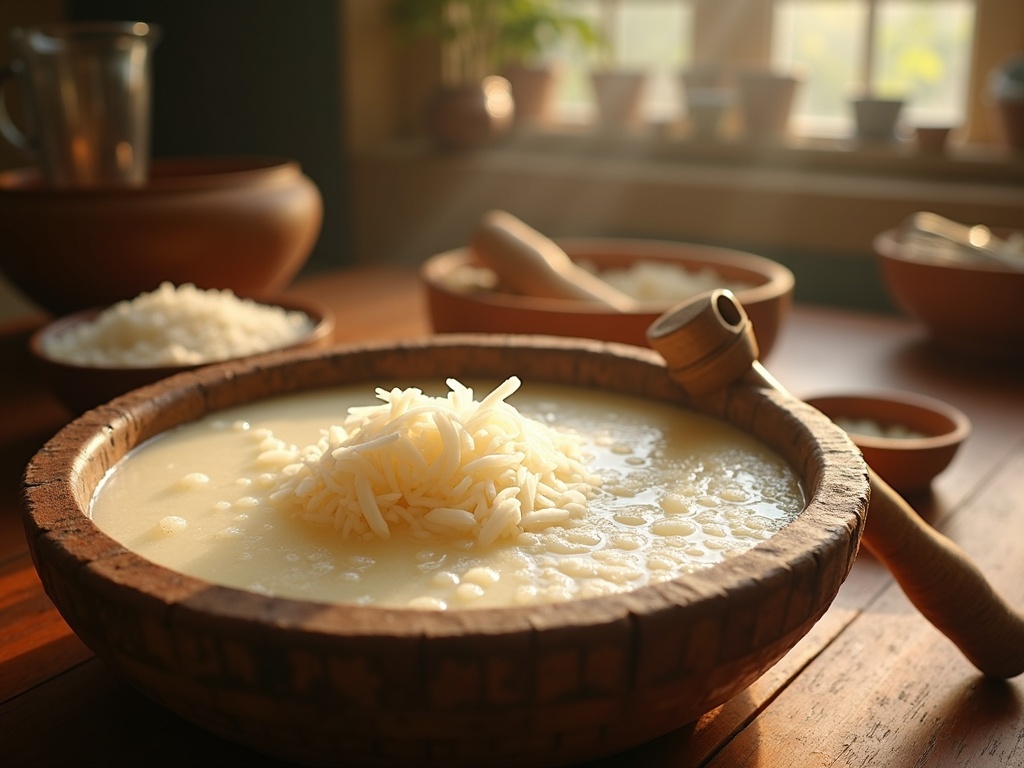
Cooking Your Appam
Getting your appam just right requires paying attention to a few crucial details. I’ve perfected this technique after numerous attempts and can share exactly how to achieve that signature crispy edge with a soft, spongy center.
Preparing Your Pan
I always start by heating my appam chatti (traditional pan) or a non-stick pan over medium heat. This temperature control is essential – too hot and your appam will burn before cooking through, too cool and it won’t develop that lovely lace-like edge. Once the pan is properly heated, I lightly grease it with a small amount of oil or ghee. I use a folded paper towel held with tongs to spread just a thin layer – excess oil can make your appam preparation greasy rather than light and fluffy.
The Perfect Pour and Cook
The pouring technique makes all the difference in creating that distinctive appam shape. I take a ladleful of the fermented batter and pour it right in the center of the hot pan. Then comes the crucial step – immediately swirl the pan in a circular motion to spread the batter outward. This creates the thin, crispy edges while leaving the center thicker and softer.
I let the appam cook undisturbed for about 3-4 minutes. You’ll know it’s cooking properly when you see tiny holes forming across the surface – these are signs of proper fermentation. The edges should gradually turn a beautiful golden brown while the center stays white and soft. Unlike rice dishes that need stirring, appam should never be flipped during cooking.
The center should remain slightly moist and pillowy – that’s the traditional texture you’re aiming for. If you find the center is too wet, you can cover the pan for the last 30 seconds of cooking to help it set without overcooking the edges.
I carefully remove each appam with a flat spatula and serve immediately for the best texture and taste. They pair wonderfully with korma or coconut stew, creating a perfect balance of flavors between the slightly tangy appam and rich curry.
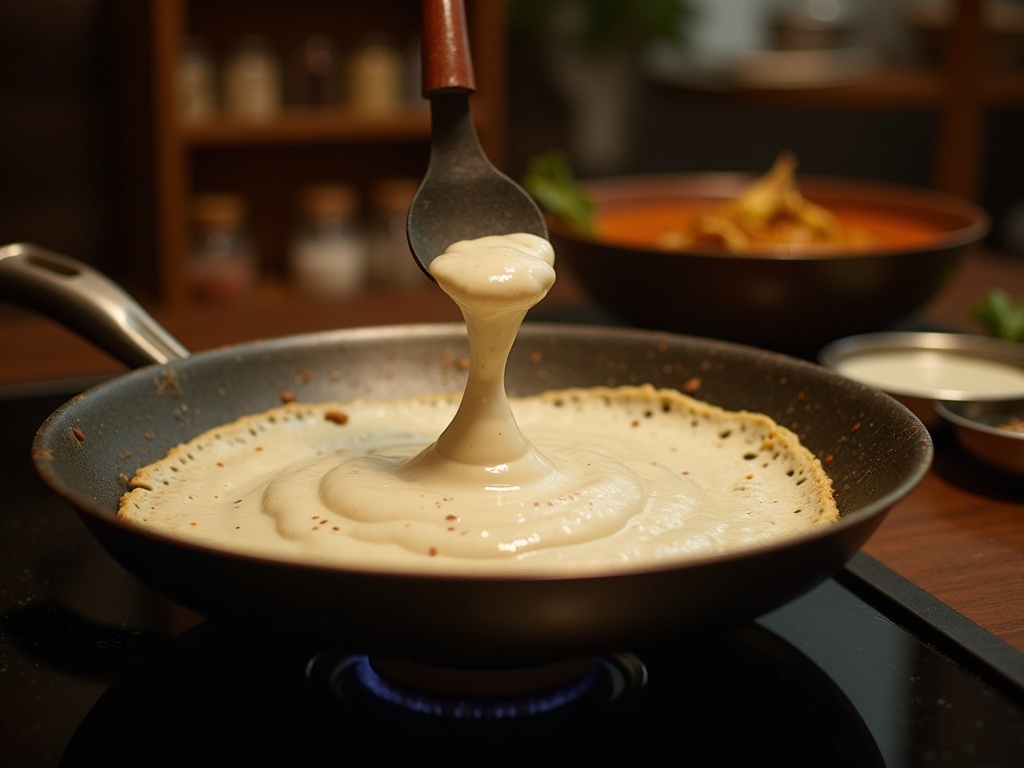
Serving and Pairing Options
Appam reaches its full potential when paired with the right accompaniments. I’ve found that this delicate rice pancake shines brightest alongside traditional Kerala dishes that complement its subtle flavor profile.
Traditional Pairings for Appam
The most authentic way to enjoy appam is with Vegetable Ishtu, a fragrant vegetable stew cooked in coconut milk. The creamy texture of Ishtu soaks perfectly into the lacy edges of appam, creating a harmonious blend of flavors. For non-vegetarians, Mutton Stew makes an exceptional pairing – the rich, aromatic gravy pairs beautifully with the mild sweetness of appam.
For a simpler but equally delicious option, I often serve appam with plain coconut milk. This combination highlights the appam’s natural flavors and creates a light yet satisfying meal. You might also consider these additional pairings:
- Sweet coconut milk infused with jaggery or palm sugar for a breakfast treat
- Chicken korma for a special weekend breakfast
- Dal makhani for a north-south fusion meal
- Sambar for a hearty vegetarian option
Appam is at its absolute best when eaten fresh off the pan. The ideal appam has crispy lace-like edges with a soft, pillowy center – a texture that diminishes quickly as it cools. That’s why in Kerala households, appams are typically cooked to order and served immediately.
As a cherished breakfast staple across Kerala, appam brings families together around the table. I’ve noticed that many households prepare a variety of side dishes to accommodate different preferences. Some family members might enjoy their appam with a savory vegetable pulao while others prefer it with sweetened coconut milk.
For a complete Kerala breakfast experience, consider preparing dhokla or other small bites to accompany your appam feast. This approach offers guests variety while showcasing the versatility of this beloved dish.
Remember that timing is crucial – aim to serve appams immediately after cooking to experience their authentic texture and taste. The combination of hot, freshly made appams with your choice of flavorful accompaniments creates a memorable dining experience that captures the essence of Kerala cuisine.
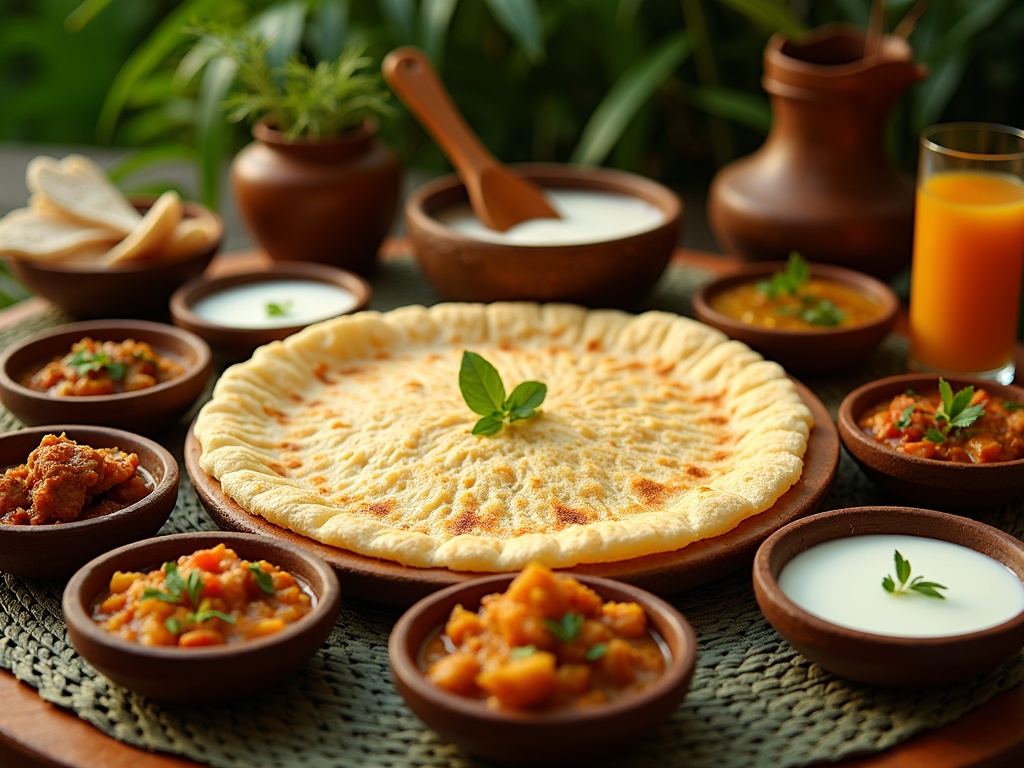
Health Benefits and Nutrition
Appam delivers a satisfying eating experience while maintaining a moderate caloric profile. Per serving of 3-4 appams, you’ll consume approximately 250-300 calories, making it a sensible choice for regular meals. Each serving provides 4g of protein, 3g of fat, and 50g of carbohydrates – creating a balanced macronutrient distribution that keeps you energized without feeling heavy.
Digestive and Dietary Advantages
The fermentation process gives appam a distinct advantage for gut health. When the batter ferments overnight, beneficial bacteria develop, creating a natural probiotic effect that supports your digestive system. I’ve found this makes appam easier to digest than many other bread alternatives.
For those with dietary restrictions, appam offers several benefits:
- Naturally gluten-free, making it ideal for those with celiac disease or gluten sensitivity
- Contains fewer additives than commercial gluten-free products
- Offers a lighter alternative to heavy wheat-based breads
- Provides complex carbohydrates for sustained energy
Appam truly shines when paired with protein-rich accompaniments. While delicious on its own, combining it with a flavorful chicken korma or hearty sambar creates a complete meal with improved protein content and nutrient density. These combinations help balance blood sugar levels and provide sustained energy.
The coconut in appam adds beneficial medium-chain triglycerides (MCTs), which your body can use efficiently for energy. I particularly appreciate that appam offers substantial satiety – that feeling of fullness that prevents overeating later in the day.
For those watching carbohydrate intake, consider serving appam with protein-rich dal makhani to create a more balanced glycemic response. The combination of protein and fiber helps moderate the carbohydrate impact while still enjoying this delicious South Indian specialty.
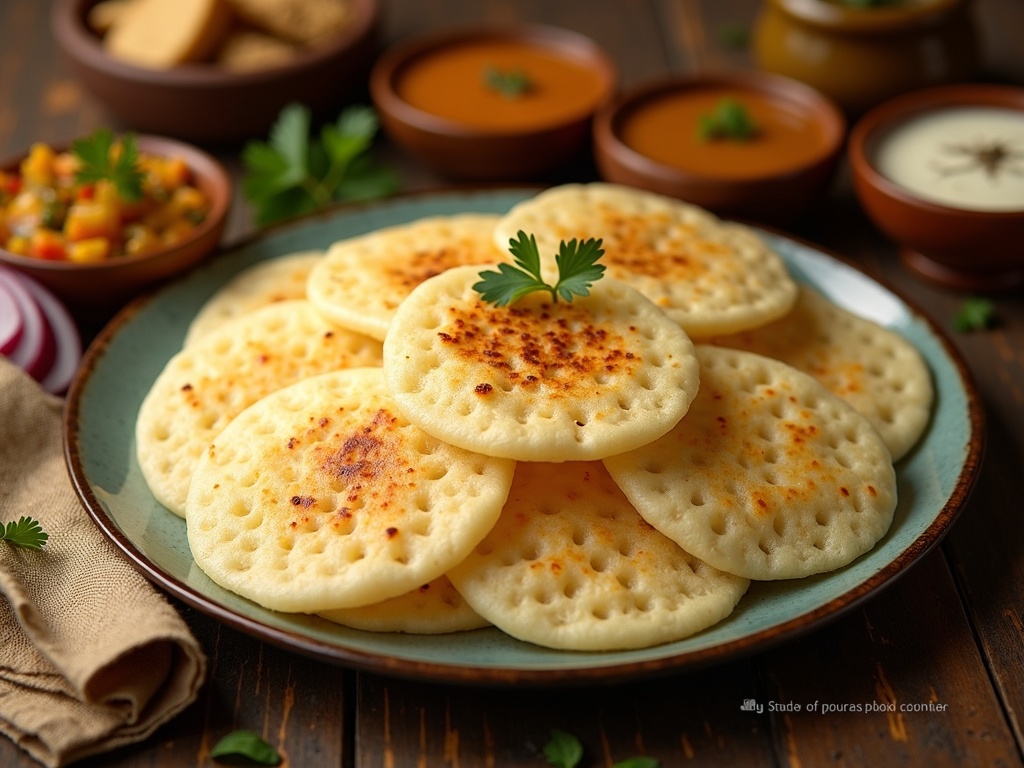
Sources:
The Kerala Kitchen, by S. B. Rajan
Appam Recipe: Traditional Kerala Pancakes, by S. R. Nair
Health Benefits of Fermented Foods, by The American Journal of Clinical Nutrition

